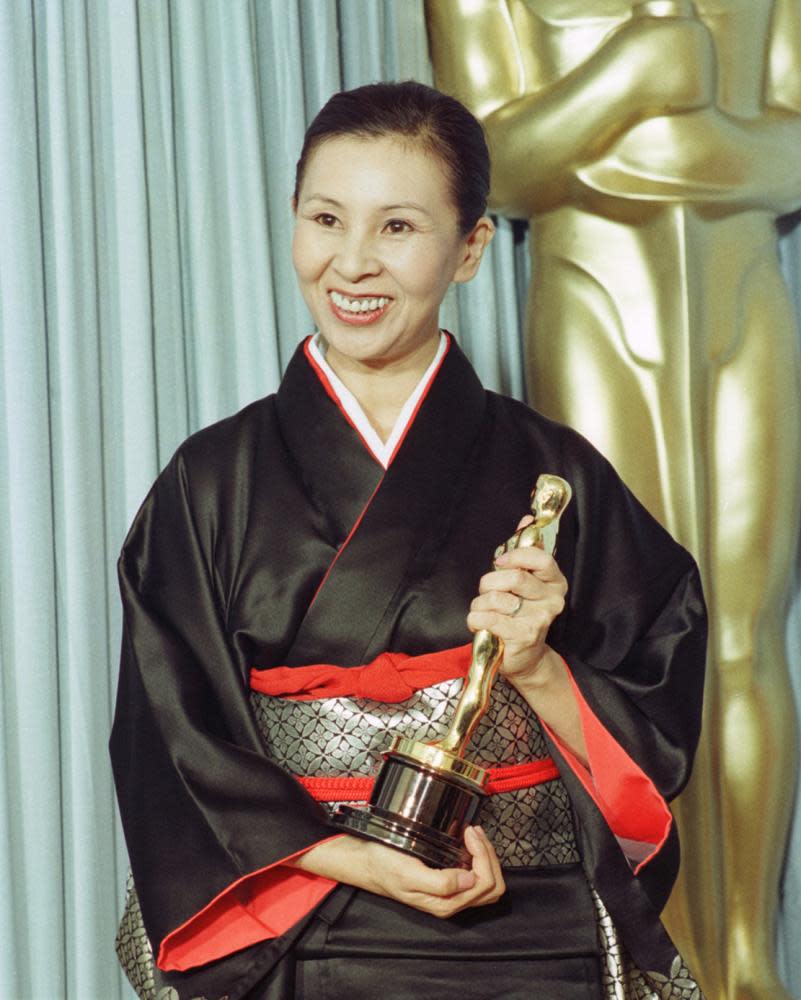Emi Wada obituary
The costume designer Emi Wada, who has died aged 84, won an Academy award for her work on Ran (1985), Akira Kurosawa’s epic adaptation of King Lear, which transposed the play to ancient Japan. Of the four nominations received by the movie, hers was the only one to be converted into a prize. Accepting the Oscar from Audrey Hepburn, she held the naked statuette and observed: “This figure doesn’t need my costume.”
Wada, who also worked in theatre and opera, spent three years on Ran. She designed and helped to manufacture almost a thousand costumes for Kurosawa’s film, fusing influences that ranged from Noh theatre to the Renaissance. She weaved yarn that she had dyed herself, and drew inspiration for the colour of one character’s costume from Botticelli, incorporating that painter’s influence into a Japanese kimono. “It is really demanding to create costumes that are both faithful to history and innovative,” she said. “But for me, trying something new in every project is a must.”

She maintained that the ultimate effect, and the truthful expression of character, were more important than strict historical fidelity. “Even in the case of period dramas, we have to remember that the audience is made up of our contemporaries. While we try to preserve certain historical elements of plays set more than a hundred years ago, I add modern colours to the mix.”
When production on Ran was suspended due to financial problems, Kurosawa shut down all departments except for costume. Having already commissioned the fabrics she needed, Wada pledged her own money to pay for the $200,000-worth of materials that had already been ordered from four factories in Kyoto. When a Japanese company stumped up the money to resume production six months later, she burst into tears. “It was six in the morning,” she said. “Kurosawa called and told me we had the money. My tears just streamed out.”
It was not unknown on Ran for the entire crew and hundreds of extras to spend many days waiting around for the director’s preferred clouds to materialise in the sky before he would begin shooting. Wada described him as “a perfectionist who would never compromise until he got what he wanted”.
She might have regarded him as a kindred spirit: when Chinese water failed to produce the precise shade of red she had wanted for the sumptuous costumes on Zhang Yimou’s Hero (2002), it was said that she got through truckloads of mineral water before arriving at her preferred dye. For that film, she also crafted a minuscule flower for the robe worn by the actor Zhang Ziyi, telling the cinematographer Christopher Doyle: “Please, shoot the flower clearly.”
Wada was born in Kyoto, Japan, to a prosperous family. Educated at the Kyoto City University of Arts, she hoped initially to become a painter. But after marrying the television director Ben Wada at the age of 20, she agreed to design for him. It was not until 1973 that she made her film debut, when she provided the lavish, lively costumes for Marco, a knockabout US-Italian musical comedy with Desi Arnaz Jr as Marco Polo and Zero Mostel as Kublai Khan.
It was another 12 years before she returned to cinema with Ran, but her success on Kurosawa’s picture kickstarted a film career. She collaborated with another revered Japanese master, Kon Ichikawa, on The Hall of the Crying Deer (1986), set in 19th-century Tokyo, and the fantasy Princess from the Moon (1987). When Hiroshi Teshigahara, whose 1964 film Woman in the Dunes is one of the masterpieces of Japanese cinema, returned to film-making after a 17-year absence with Rikyu (1989), he enlisted Wada to design the costumes, among them the extravagant brocaded robes, for his 16th-century characters. The following year she was reunited with Kurosawa for the whimsical Dreams (1990).
Her costumes enhanced the lyricism of the martial arts romps The Bride with White Hair and its sequel (both 1993). In the same year, she shared with the director Julie Taymor a Primetime Emmy for Taymor’s ambitious production of Stravinsky’s opera Oedipus Rex, starring Philip Langridge, Bryn Terfel and Jessye Norman; staged at the Saito Kinen festival in Japan in 1992, it was filmed for the Great Performances strand on PBS. The New York Times included Wada’s contribution, containing “echoes of classical Japanese drama”, among the elements that it said lent the opera its “extraordinary power”.
Wada continued to divide her time between cinema and opera. She made three films with the British director Peter Greenaway: Prospero’s Books (1991), for which she designed the embroidered cloak worn by John Gielgud; The Pillow Book (1996); and 8½ Women (1999). Other screen credits include Nagisa Oshima’s gay samurai drama Gohatto (also 1999), Yimou’s House of Flying Daggers (2004) and two films for Tian Zhuangzhuang, The Go Master (2006) and The Warrior and the Wolf (2009).
On stage, her work this century included a 2002 revival of Stephen Sondheim’s Pacific Overtures by the New National Theatre, Tokyo, and Tan Dun’s The First Emperor, directed by Yimou first in 2006 and then in a streamlined version two years later; both iterations were staged with Placido Domingo at the Metropolitan Opera in New York and featured hundreds of Wada’s dazzlingly coloured costumes.
She remained discerning and principled in the work she took on, turning down the opportunity to design the 2005 film Memoirs of a Geisha, for instance, because it depicted “a Japan of the American’s imagination”. Her final film was Love After Love, directed by Ann Hui, which premiered at last year’s Venice film festival.
Her husband died in 2011.
• Emi Wada (Noguchi Emiko), costume designer, born 18 March 1937; died 13 November 2021

 Yahoo Finance
Yahoo Finance 